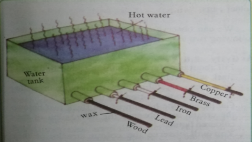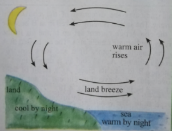Back to: PHYSICS SS1
Welcome to class!
In today’s class, we will be talking about heat transfer. Enjoy the class!
Heat Transfer

Introduction to heat transfer
We have said that heat moved between two points whenever there is a temperature difference between the two points. The methods by which heat moves from one place to another are:
- Conduction
- Convection
- Radiation
Conduction:
This is the transfer of heat energy through a material medium from one point to another by the vibration of molecules of the medium. There is no gross movement of molecules from the hotter to the cooler region. Conduction occurs mostly in solid, though liquid and gas conduct heat a little. Most liquid and gases are poor conductors of heat.
Also, not all solids are good conductors of heat. Metals such as silver, copper, aluminium, iron, brass etc are good conductors of heat while solids such as wood, clay, plastic, glass, ceramic, etc are poor conductors of heat.
Convection:
Convection is the mode of heat transfer by the movement of molecules of the medium from a hotter area to the cooler area. Convection occurs in liquid and gas. Convection cannot take place in solid since molecules of solids have fixed positions and cannot travel from one place another.
Radiation:
This is the mode of heat transfer, which does not require a material medium. This is the process of heat transfer through a vacuum. The heat energy is transmitted in the form of electromagnetic waves. The heat energy from the sun passes through space (vacuum) by radiation to reach the earth.
Experiments to illustrate conduction, convection and radiation
Conduction:

Conduction
From the experiment, you will need two rods of equal lengths, one made of iron and the other of wood. Insert the rods in the side of the vessel as shown in the diagram above. Place some candle wax at the outer end of each rod. Boil some quantity of water by means of an electric heater in the vessel. Ensure that the ends of the rod in the vessel are well immersed in the water. You can keep the water boiling using the electric heater. After about 5 minutes, observe that the candle wax on the Iron rod has started melting while the wax on the wooden rod remains intact. This show that heat energy from the boiling water has been conducted to the end of the metal rod faster than the wooden rod. This shows that the metal rod is a better conductor than wood.
Convection:

Convection
Place a few solids particles (e.g. sawdust) in a baker. Pour some water into the beaker and heat gently by means of a bunsen burner. As the water is the heater you will observe a current of the motion of the solid particles in a circular pattern. This is the way water molecules are moving in transferring heat by convection. We call it convection current.
Radiation:
Stand some distance away from a fire set up or allow your pressing Iron to be very hot and place your face some 20cm from its surface. What do you feel in both cases? You will feel the heat of the fire on your body though you are far away from it. Likewise, you will feel the heat from the Iron on your face. In both cases, the heat actually flows from its sources to you by radiation.
Application of heat transfer in everyday life
Conduction:
- Cooking pots are made of metals, such as aluminium because metals are good conductors of heat. This allows heat to be conducted easily and quickly into food being cooked in the pot.
- Handles of cooking pots and pans are made of poor conductors of heat such as wood, plastic, etc. Thus, the handles are not hot when the pot becomes hot during cooking. The pot or pan can therefore be handled without burning one’s fingers.
- On sunny days, thatched houses and those roofed with asbestos sheets are generally cooler inside than those roofed with aluminium sheets. This is so because the thatch or asbestos insulates the house better than aluminium.
- During cold then weathers, sweaters or cloth made of thick woollen materials are worn to insulate the body and prevent heat loss from the body. The body is therefore kept warm.
Convection:
- When a house is constructed, the good architecture ensures that the windows are well arranged to allow circulation of air. This is called natural convection. Warm air rises and escapes, allowing cooler air to flow into the house
- Fans are used to induce (force) circulation of air to ventilate rooms. This is called forced convection.
- In coastal area natural convection occurs by means of Land and Sea heat breezes. During the day, the land heats up faster than the sea. Hence, it is hotter. The hotter air over land rises because it is less dense cooler air from the sea flows into the land to cool it.


The reserve is the case at night. The sea retains the heat absorbed during the day. Therefore the land is cooler than the sea at night. Cooler air from the land flows to the sea, while warmer air from the sea flows towards the land. Such coastal areas are therefore cooler in the daytime and warmer at night.
Radiation:
- The heat from the sun gets to the earth by radiation. This heat has so many applications in our life such as drying, heating, etc.
- Thermos flask: this is designed to reduce heat inflow into the flask or outflow from the flask. Hence the flask keeps the temperature of its content steady for a long time.
The special features of the flask that reduces the heat exchange between it and its surrounding are:
- Vacuum in-between double wall glass vessel. This prevents heat transfer by conduction and convection.
- The silvery walls of glass minimize heat transfer by radiation. Since “shining surfaces” are poor absorbers of heat, the glass walls do not allow heat to pass through them.
- The stopper (Cork) is an insulator. This reduced heat transfer by conduction. For not allowing the vapour of the liquid to escape, the cork also reduces convection and evaporation.

In our next class, we will be talking about Electric Charges. We hope you enjoyed the class.
Should you have any further question, feel free to ask in the comment section below and trust us to respond as soon as possible.

❤️❤️
Wow 🤩 I love this 😍